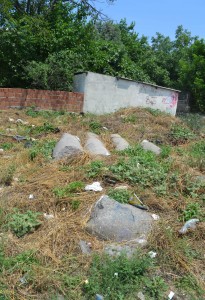The shallow lake to the west of Istanbul has not been seen as a desirable location in the last few decades. However, it used to be a magnet for recreation seekers, including Atatürk. Further back, when the lake provided a nice stop on the Via Egnatia, the road to Constantinople, this was a flourishing town of opulent summerhouses for the rich. Mamboury studied the extensive remains to the south-east of the lake (40.987422,28.777431) and claimed that this was the Byzantine town of Rhegium. Later researchers identify it as Roman Bathonea. The remains are thin on the ground now. Four and a half columns buried by dumped grass mowings. These probably come from one of the churches or chapels that made up a fair proportion of the imperial compound.
Still, when you look from the columns over the field of drying wool to the blue water of the lake, you can get a vague idea of what a good site this was for a palace. Better preserved remains on the relatively uninhabited north-west shore (41.032978,28.734012) have been labelled as part of Rhegium but other researchers call this area Bathonea. Whatever the name, this area has been settled for a long time, as remains associated with Pleistocene hominids in Yarımburgaz Cave (41.074563,28.742815) testify.
- Four and a half columns

Categories: Uncategorized | No Comments »





